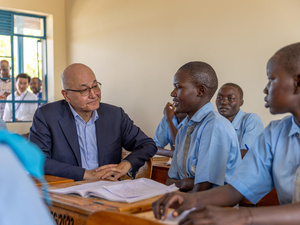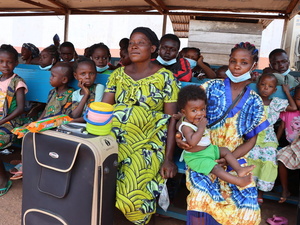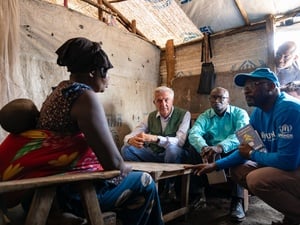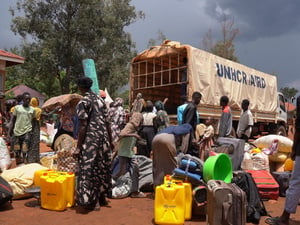Capoeira brings leisure and peace-building for refugees in northern DR Congo
Capoeira brings leisure and peace-building for refugees in northern DR Congo

Central African refugees practice capoiera in front of a rapt audience at Mole camp in Equateur province, Democratic Republic of the Congo.
MOLE REFUGEE CAMP, Democratic Republic of the Congo, September 19 (UNHCR) - It's a hot, muggy Saturday afternoon in the Mole refugee camp, but while many people are taking a siesta, a hardy group of young men and women are indulging in their new obsession - capoeira.
The Brazilian martial art includes elements of dance, acrobatics and music, and it is keeping people occupied and fit as well as helping ease tension between different groups of Central African Republic (CAR) refugees in this camp of more than 13,000 people in the far north of the Democratic Republic of the Congo.
"Everyone can do it, women, elderly people, mothers and fathers. They can do it because it is a game. It can become an art to practise peace," says Maxime Obingui, a 37-year-old from Bangui. "Christians and Muslims are doing capoeira. We train together. We want to be together, like a family," he adds, alluding to the inter-communal conflict across the nearby Obangui River in his country.
Capoeira was introduced to the camp two months ago by a local aid group, ADSSE (Association pour le Developpement Social et la Sauvergarde de l'Environnement), which wanted to broaden the range of leisure activities available for young people in Mole. It has proved a great hit.
"Capoeira is a new sport for me. I discovered it here. I like it because I like the rhythm and the music," says 28-year-old Armand Kouissi, who has taken to it like a duck to water and is nicknamed "Capoeira Man." He also saw the peace-building possibilities of the activity.
"I also see it as a tool to promote peace. At the beginning, we had some tensions, but thanks to capoeira we now get on well. Sports unite people," he says, adding: "We think that capoeira is a tool that can be used to promote peaceful cohabitation in the camp. When we talk to people watching us during our training, we convey messages of peace."
Most of the refugees in Mole, which opened in July 2013 to cope with the exodus from the Central African Republic, are from Bangui, including many secondary school students and young people in higher education. The fact that they are missing out on their education has created tensions and frustration.
That's one of the reasons why these people fleeing violence have embraced, ironically, a martial arts. "I feel better when I do capoeira; I forget everything that happened to me, even in Bangui. Before, the atmosphere was not good in the camp, says 19-year-old Eric Moussa, who was studying literature in Bangui before he had to flee for his life and catch a boat across the Oubangui to safety.
He's among 40 refugees who have signed up for the capoeira classes organized by ADSSE, which runs the project with UNHCR support. Scores more are interested in taking part in the training sessions on Monday, Wednesday and Friday, learning from CDs and the more experienced students. Demonstrations are given on weekends.
"What I like in capoeira is the game. I like the movements and I like the music. I don't miss any training. Capoeira changed the camp. Before, life was more difficult but now the camp has changed for the better," Marie-Sabine, aged 38, enthuses. One day you have to take me to Brazil," she adds.
Meanwhile, plans are afoot by UNHCR to get capoeira masters to visit the camp and teach refugees the basics as well as advanced skills in an activity that uses power, speed and leverage for a wide range of kicks, spins and complex moves.
Stefano Severe, UNHCR's representative in the DRC, said the agency was in touch with a capoeira group in Kinshasa and the Brazilian Embassy to investigate this possibility. Citing the positive impact of capoeira in Mole, he said: "We should not miss this opportunity to contribute to the construction of peace among CAR refugees. Contributing to peace among refugees also contributes to bringing peace to the Central African Republic."
And "Capoeria Man" Kouissi believes it can continue to play an influential role by promoting reconciliation and cooperation once the conflict is over and people have returned to their homes in the Central African Republic. "It brings so much joy. We would like to bring it to Bangui. If one day we can go back to our country, we will apply this art there" he adds.
By Céline Schmitt in Mole Refugee Camp, Democratic Republic of the Congo








